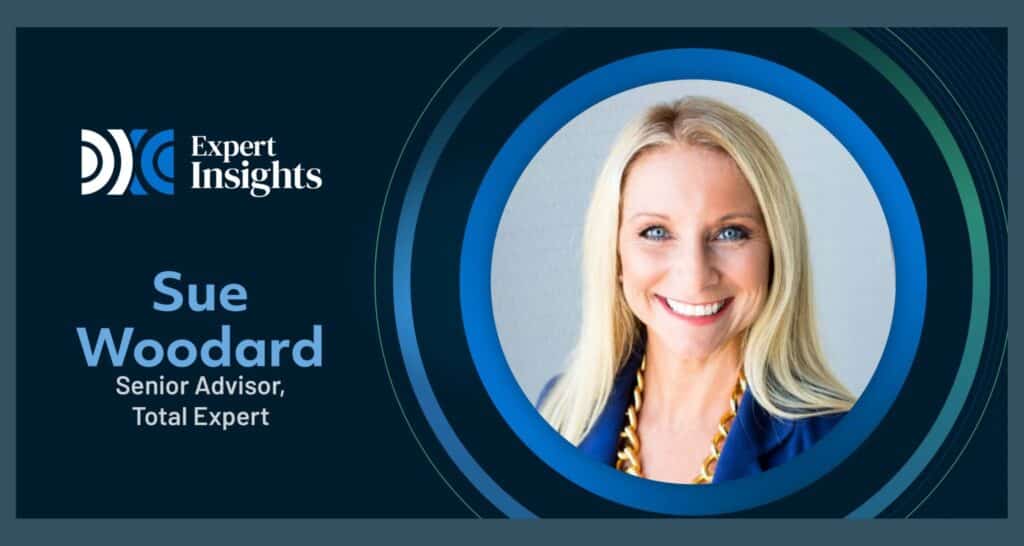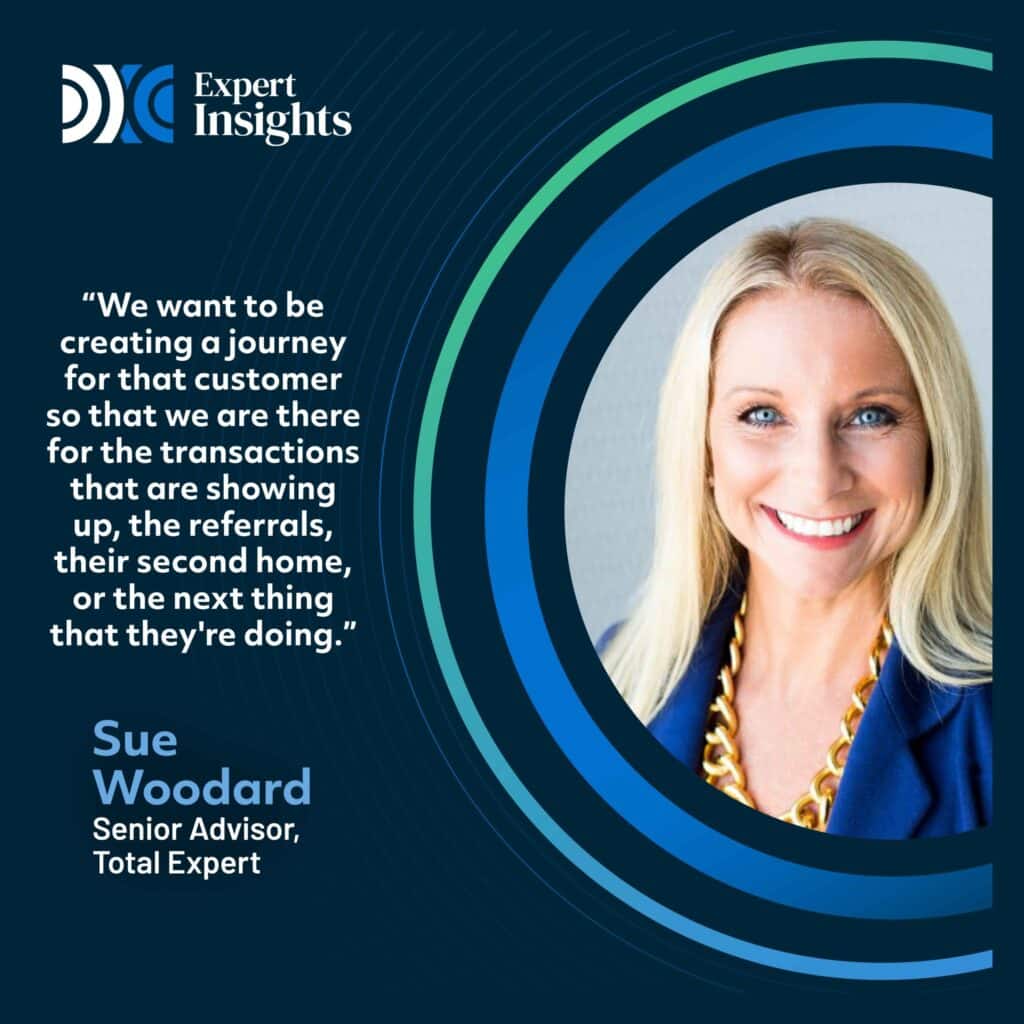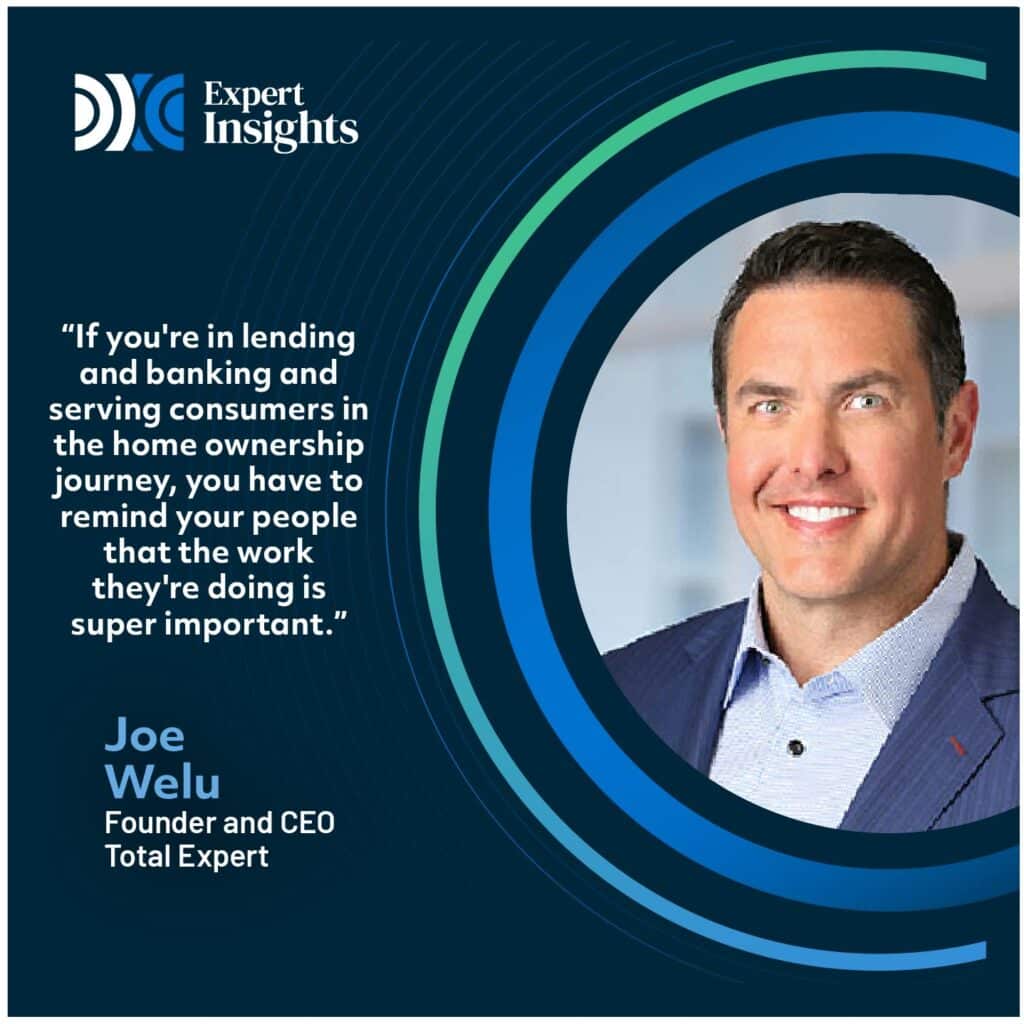
Prioritization is more important than ever as lenders look for ways to grow their businesses. Customer acquisition will certainly be a key component in this regard. Fintech evangelist Sue Woodard joins Joe Welu in the Expert Insights studio to discuss the top priorities for lenders in 2023. She explains how to operationalize the right things in your organization and offer consumers with high-quality advice to help them make their homeownership dreams a reality. They share the mindset that will allow lenders to win in any market and keep their customers coming back for life. Tune in for their insight.
Watch the episode here
Listen to the podcast here
The 2023 Growth Playbook: Customer Acquisition With Sue Woodard
Welcome, everyone. Sue, thanks so much for joining us. I’m joined by Ms. Sue Woodard. Sue needs no introduction to the industry. She serves as a Senior Advisor to both TotalExpert and the STRATMOR Group. She has been in the lending space as an industry expert thought leader for 30 years. We are going to get into some relevant topics about what’s happening in our space now. You’ve got a unique perspective in your capacity at STRATMOR and being involved with so many great organizations. You have a lot of conversations. Over the last couple of months, as we’ve spoken, you have been involved in a lot of workshops across multiple companies. That’s dozens of different top companies in lending. You get to hear about what they’re thinking about. Unpack that a little bit for us. What are you hearing? What are the priorities?There’s a lot going on, which certainly everybody out there knows. I’ve had the very unique opportunity to sit in not just at the conferences that we’ve been at with meetings, but some workshops with top lenders and top executives. They’re talking about what they’re focusing on and what they’re not focusing on right now.
One of the things I heard from a CEO session when they were talking about these kinds of things is that if they were making investments in the year ahead, those investments are only going to be on cost-cutting, compliance, and customer acquisition. It’s not just because of alliteration. That struck me because I thought this is the real deal right now. With the market that we’re in right now and how things have declined, people are getting serious. What stood out to me was you have to be focused on customer acquisition. To me, that is the most important thing that people can do to build their success for 2023.
That makes total sense. Prioritization is so critical at all times in building companies. It’s even more important arguably than it has been in a long time to be ruthless about your priorities and where you’re investing resources as an organization. I agree from my perspective that the ability to acquire customers is going to be critical. We’ve talked about this in the past. You can’t cost-cut your way to success. You have to right-size your business if you’re out there as a banker or lender that has scaled up over a couple of years. You’re right-sizing the business, but ultimately, it all comes back to being able to attract, acquire, and retain customers.

I was looking at the numbers. It looks like the estimate for the purchase volume is sub-five million units, which is still a lot of transactions for 2023. It’s lighter than it has been. As you’re hearing them talking about customer acquisition, what are the themes that are coming to light? How are they thinking about it differently now than maybe they would have a few years ago when customers were falling from the sky?
It’s interesting the differences that I hear also in conversations. There are some lenders that I’ve heard that are so focused on cost-cutting. To your very good point, they’re not paying enough attention to customer acquisition. It’s understandable the position some people are in. One of the things that I’ve observed is that people will say, “I didn’t know the market was going to change,” and so forth. Nobody expected it was going to change overnight. You go up a hill and think you’re going to go down the hill. Instead, we went up a hill and came over a cliff on the other side. People are still dusting off from that.
However, what I am hearing is the companies that I’ve got my eye on where I’ve said, “These are the ones that are talking about the right things,” are the ones that are focusing on customer acquisition as a way to gain market share. When you think about that, over the last few years, people have gained all kinds of customers in their databases. You’ve got people you didn’t have in there before.
Now, what are you going to do? What are you going to do with this amount of data that you have in your database, the number of people, real humans and families that are in your database that are going to need additional services from you? They are going to do repeat and referral transactions. We saw over the course of the last couple of years that the retention rates were abysmal. It was 18%. That is what we saw.
The retention rates over the last couple of years have been abysmal, with ratings reaching 18%. Share on X
Don’t you think part of that was you had the luxury of not caring if you’re going 100 miles an hour?
1,000%. There were people that turned off some of their marketing because they’re like, “We’re buried. We can’t do anymore, so we’re not going to stay in contact anymore.”
It’s a logical thing for businesses as they enter these phases of hyper-growth, which is a lot of the case. In some cases, you become a little bit of a victim of your own success. With some of that, that certainly happened to where you acquired more customers than you ever had, but you didn’t have to care at the level that you need to build lifelong relationships.
The other thing that happened is that there was what I’ll call a muscle memory that was built over the last few years in leaders and organizations where it’s reactive, and where we are going to sit back and try to get people through as fast as we can. That is not the mindset that we can afford to have as we charge into this new market. It used to be you could stand there with a bucket and consider yourself a rainmaker because it was going to come to you. Now it’s got to turn into something very proactive. What do we do with this amazing gift of all of these people that are now in our databases? What’s next?
When it comes to the topic of customer acquisitions, I’ve got a number of things that I believe are at play here. The consumer’s needs are arguably different from the perspective of how they approach the lending process. We talked a little bit about this before we went on air, to now where the high-quality advice, consumers need that more than they ever have. That has to play into your acquisition strategy being able to enable your sales organization to make sure their mindset and their approach are correct. This is my perspective, but I want you to give me feedback on this. What are you hearing? Are you hearing that talked about that they’re going all the way to, “We have to rethink how we’re doing the whole process of engaging with customers?” Are they going that deep?
Yes, 1000%. The smart lenders are. The ones that I’ve got my eye on are the ones who have said, “We need to re-examine our entire customers’ journey and make sure that it is tooled for repeat business, referral business, how we are working out there in the market, and how we are going to attract and acquire more customers.” It is going to be more competitive. When you get those leads, how are you communicating with them? It cannot be the same way you’ve been doing it for the past couple of years.
This is my interpretation, but they’re almost, in a way, re-examining how they’re adding value to not just their customer but also referral partners and other business partners in the finance ecosystem. In the lending space, people deal with accountants, wealth managers, realtors and builders. They’re re-examining how they add value to all of those stakeholders. Is that accurate?
Yes. It’s interesting, we’re all consumers too. Maybe some of us have purchased homes, refinanced homes, or have done some kind of financial transaction. Are those people in contact with us in the way that we would expect or they’re so busy that they don’t care? That has been my experience. That has been shocking to me. When you don’t hear from a realtor or a lender, you think, “How much does it matter?”
I’m seeing the smart companies sit down and retool, “What does it look like to work with that prospect? How are you communicating? How are you working with that customer or that referral partner, but also making sure that you’re in tune with, “We’ve gathered all this wonderful data in our databases? What are we doing with it?” The 1003 goes deep. More than any other financial professional learns about a consumer, we learn on the 1003. What a disaster to sit back and not do anything like that.
Think about the financial picture that you have. We’ve started talking about this concept. It’s not just a concept, but it needs to happen foundationally. As a top lender, you should be able to look at this comprehensive financial profile of every customer. Everybody that’s ever applied with you, some of those people didn’t necessarily transact with you. Anybody that you have any information about doing business with you, you should have a profile of that person, and then be able to communicate and engage with them based on all of that information that you know. Getting that motion down is something that certainly, as you look at customer acquisition for the next 12 to 18 months, does matter that you maximize every single lead or every single prospect.
We’ve known it because we’ve seen the data for so long. It is about showing up at the right time with the right message and communicating in the right ways. Often, there’s such a big move in the broader financial landscape to what I’ll call embedded finance, where you’re in the midst of doing a transaction. Consumers aren’t thinking about a car loan. They’re thinking about a car. They’re certainly not thinking about a mortgage. They’re thinking about their home and what’s happening in their life experiences.
You must show up at the right time to entertain every prospect. Be sure to bring them the right message through the right communication approach. Share on X
That means that smart lenders have to be aware of what those activities and experiences are that are happening and be right there communicating the right message at the right time. The only way that can happen is if you do pull up and say, “What’s currently happening now? How are we communicating right now? How are we in the market right now? What do we do when somebody responds to our lead? Are we dripping on their head a couple of times, and then who cares what happens after that? Are we being a bit more intelligent in how we are crafting our messages and being responsive to them, reacting or not reacting?” We can now do all this. This was a pipe dream twenty years ago. We can do it and we need to do it now.
I was talking to a couple of technology leaders. We were talking in general terms about what’s possible now. What’s possible in the execution of what’s possible can be two different things. If you think about it, as long as you’re being ethical about what you’re doing with data, respecting consumer privacy, being compliant, and all of those things, it’s incredible the story that you can start to unpack about what’s going on in a customer’s life.
If I think about a lender that wants to maximize customer acquisition and understands where your set of customers, prospects, and leads are in that journey, and what’s important to them, it will make or break whether you do well, relatively speaking, over the next twelve months or you’re going to struggle. Do you agree with that approach?
I 100% agree with that. It’s one of the differences that has happened too over the last 5 or 10 years. Consumers are more eager to get financial advice and financial information and get that right message from the financial institutions that they’re working with. Sometimes, people will hold back or deliver, “Here’s our product,” or, “Here’s our something.” That’s not how consumers think. Consumers are thinking about, “I have a need. I’m trying to figure out my budget. I’ve got a life event happening. What can you do for me?” That’s one of the most important things. People are more willing than ever before in history to give up data and information about themselves if they’re going to gain information, advice, guidance, and education that is helpful to them in their life.
The three things we always ground on are to educate, engage and advise. The advice part is a moment of differentiation for a lot of lenders. I want to go into this a little bit. As you’ve had conversations and been a part of some of these strategic conversations of companies that are trying to make decisions today that will set up how they do in the next year to two years, give me some perspective on how they are thinking about educating the customer, and the role of the lender, the professional, the originator, the advisor, the mortgage loan officer, or whatever the title. How are they thinking about educating the customer as part of their value proposition and part of their customer acquisition strategy?
I was in a session that was talking about home equity lending. A lot of the folks that were in there aren’t able to do home equity lending in a way that’s maybe profitable to them or they don’t have the right outlets for it. However, I heard several of them say that they still want to be in the conversation. The ones not talking about it then off they go to some other financial institution, they still want to be there and be seen as that financial guide for them. With that mortgage, we learn about every single part of their financial life.
Think about the service that you can do for someone when you are able to be involved. If you are an IMB, you’re not going to be able to serve every single need, but don’t you want to be that person that they’ve given you all this information and they would like advice? The best lenders I’m hearing are saying, “We still want to be in the conversation.” We want to know what’s going on with this consumer’s life. We want to be creating a journey for that customer so that we are there for the transactions that are showing up so that we’re there for the referrals. We’re there for that second home or the next thing that they’re doing.

We see this on a lot of levels, but it’s more profound now to where the practitioners, top producers, and lenders have elevated themselves to that status that you talked about to where the customer wants them and the consumer wants their opinion. They want guidance. They want to understand, “What are the impacts of me making this decision to buy a house today or rent for another year?” The ones that are in that position are doing better in this environment in order of magnitude. That’s what our data shows.
As people are reading this, they’re saying, “I’ve got all these initiatives.” I don’t think anything we’re talking about is that incredibly difficult to execute, quite honestly. It is because it is talking about paying attention to whether you have documented it. What does your journey look like for a lead, for a customer that’s in your database, or for a referral partner? What does it look like and what kind of content are you sending? Are you utilizing intelligent automation so that you’re being reactive to what’s happening? We haven’t looked at that because we haven’t had the time.
I get it. For the last couple of years, I might not have looked at it either. We were doing all the things that you do when the market is as it is. I’m hearing these smart lenders saying, “We’re taking the time that we have been given right now.” We are going to make sure that when it’s a competitive transaction, we’re going to get it. We have been communicating information of value, education and advice. We’ve been engaging with them such that we’re going to get that next transaction because we’ve been there.
We notice this from the conversations that I have. I’m curious about your perspective. How are they thinking about the next 4 to 6 quarters, the organizations that you’re talking with? Are they getting into this mindset of the world is going to be awful for the next year to two years? Give some color to that.
There’s a lot we could talk about in terms of the mindset of the folks and what they’re thinking about, but that’s a whole other episode. What we’re hearing from a lot of people is that the first part of 2023 is probably going to be a bit challenging. I don’t think we’re done with some of the measures that people have to take in order to get their businesses in a healthy place.
What I am hearing is executives are taking a good sharp look at everything, which quite frankly, is a healthy exercise for a business. It’s to look at everything and to think about everything. Look at those costs. Know what your return is for some of these things that you’re investing in. Those are all good exercises to go through. Think critically about your people, your teams, and your leadership. All of those things are good.
How are you deploying resources like the money, the spending, the advertising, the marketing, the tech, the tools, the trainers, all of it? You have to look at every single thing and say, “How does it tie into the most important thing?” You have to be able to acquire customers. You have to be able to retain customers. It’s complicated, but it’s not more complicated than that at the end of the day.
I was in a workshop with a group of technology executives. I was surprised when I heard the question being asked about budgets for 2023. They were like, “Are you cutting? Are you staying the same?” There were a lot of good brands representing various sizes like IMB banks and everything. No one said they were cutting on the technology budget side, which I thought was very interesting. In fact, a third said they were going to be increasing their technology budget.
What about relocating spending?
We didn’t talk about that on that poll but we did go into that. We were being thoughtful about where we can ensure that our technology is helping us with exactly this topic, which is customer acquisition. As we look at the industry, we’re still going to see some more headlines that might be a little tough for us to swallow. Most people are saying that when we get to the second quarter, rates will probably come down a little bit. They probably will come down a little bit more with the continued inflation pressures, the recession, and so forth. The recessionary pressures will come down a bit further.
Property values are starting to normalize. I’ve heard a lot of people talk about how real estate agents are more excited because they can do their job. It’s not a race to the driveway to quickly write up an offer for $50,000 over lists. You’ve got first-time home buyers that have been on the sidelines for a long time that are saying, “I know rates are high, but I can look at a different type of product. Maybe I can tiptoe into the market and have a chance to look at a few properties before I have to make a decision.” In the second quarter, it’s not like it’s going to be back to party time. Is it going to start to feel normal by then? Yes.

We speak about the practitioners and the professionals. They’re able to slow down and do their job again, which is advising. Part of that advising is if you have a consumer or a first-time home buyer, they believe in the power of home ownership, which we ground on. It is the single biggest contributor to household wealth out there.
Homeownership is still long-term important. If you believe in that as a practitioner, the creativity that they need to have about deal structure and product set, how do you think about that? Is that part of that conversation? Are they going deep on examining all the options available from a product set? How do I create a scenario for this consumer to where the consumer is going and they’re looking at 30-year interest rates or 30-year fixed rates? Maybe they’re 6.5% or whatever they are and they’re like, “This is not for me.” What are the smart lenders doing?
They’re educating. You’ve said it a number of times. There’s a Freddie Mac report that comes out periodically where they talk about how consumers are looking at their financial worlds and looking at the mortgage industry. There still is an unbelievable number of people that still think you need 20% down, that you need an 800 credit score, or that there are only 30-year fixed rates. It’s amazing.
Because we’ve been in this industry for so long, and some of us are longer than others, we forget all of our customers have not been along for the ride. There is an education that is needed to say there are all kinds of options out there in terms of how much you put down, what your credit profile might look like, and about more creative things. We haven’t talked about some of the hybrid loans for a long time. It’s time to talk about them again.
There’s that thing that’s been going around. I know everybody is saying you marry the house and date the rate, but you got to divorce the landlord. There is a lot of truth to that. Find a great home that you love. Don’t let this time hold you back. It may not help. There are buyers that look and they can’t help it. It’s human nature. People are wired like people. This is how we are. You look back a couple of years and go, “I should have, would have, and could have when rates had a 2-handle, 3-handle or 4-handle.” They don’t. If you take a more historic view, which not a lot of consumers have, these are great interest rates.
Don’t you think part of the problem is the buzz in the media? If you wake up and you are thinking about buying a home, everything that you read is, “Oh my gosh.” What you don’t hear is the media or anybody breaking down the fact like, “Let’s look at this over a ten-year period.”
They compare it to rent. You’re paying somebody else’s mortgage, which is exactly what you’re doing with rent.
My perspective is the lenders that are willing to have more of those conversations with consumers as part of their customer acquisition strategy are going to have a better outcome if they can operationalize that into their sales team. You need to remind yourself that part of your job is also crafting the benefits and the value of home ownership first. Make sure you’re grounding on that with consumers and educating them on that.
Help your loan officers come back up to speed with that. You talked about practitioners getting to do their jobs and having to do that job of advising. It was as easy as in the refi run. You quote an interest rate, take the app, and you’re done. It is going back to truly what makes a mortgage loan officer such an incredibly special role or an important role. It’s because you are helping somebody get into a home where their family is going to live. Helping craft out and educate on what that looks like and how you structure that deal, there’s an amazing art to that.

For lenders, pay attention to that. As you’re thinking about how you’re recruiting and retaining your loan officers, which I know is a big topic for people as well, make sure that you are focusing on how we are providing the education and training that they might need, and what tools and resources they might need in order to do a great job educating the consumer.
One of the buckets that I believe has been missing has been the enablement and the sales training as a part of these organizations, and I’d love to hear your feedback from your conversations. Some of them have done a great job, but some of them have not done a good job at all. That’s going to matter over this next handful of quarters as to how well your organizations do if you’re enabling your people. It’s not just for the technology and the tools, but ultimately the training, dialogues and reminding. It does make a difference.
The number one thing when people talk about loan officers, going to training or adopting new things is they won’t do it. I was a loan officer, so I object to it a little bit. You know that I won’t let people say, “Loan officers are lazy.” It drives me crazy. There are lazy loan officers, but there are lazy attorneys, doctors, and everything else as well.
By and large, loan officers are 100% commissioned. That is not the profile of a lazy person. It does mean that they are going to go towards the path as a 100% commissioned salesperson should towards the path of least resistance to get the right result. Sometimes, it means they don’t want to go to that thing. We’re now in an environment where you probably do have a lot of people that are open, eager, and a little hungrier for having the right kind of tools and right resources. If you’ve tried training and nobody shows up so you’ve thrown it out, try again. This is the market to be paying attention to that.
I heard an executive say this and I thought this was an interesting point. They’ve got some things that they’re implementing and technology. In fact, one of their ROI metrics is morale because they’ve said, “Our people need it. They’re in a tough situation.” Our folks need things to grow their business, but some of it is the morale to keep them up.
What I’ve found important is you have to remind the people running your company. If you’re in lending, banking, and serving consumers in the homeownership journey, you have to remind your people that the work they’re doing is super important. Long-term, it’s not going anywhere. The American dream of home ownership is not going to go out of style. I feel like people go into the mindset of, “Oh my gosh,” almost out of fear. No matter what happens, there’s going to be a certain amount of people moving over in 2023. The questions that you have to ask are, “Are you doing the things that you need to do day in and day out? Are you using data correctly to unlock more of those opportunities for your organization?”

You said a word, which was one of my favorites, which is operationalize. I love that one because that’s the bottom line. When we’re talking about customer acquisition, how do you operationalize the right things in your organization, and how do you do it now when you have the opportunity? The exec I was talking about said, “There is going to be a next wave. No matter when or what that looks like, we are going to do the right things.” I’ve seen this organization do this over years. He said, “We’re going to do the right things right now. We’re going to invest in the right things right now. We are going to capitalize on when that next wave comes.” It’s not about being the largest or the one that has the most toys.
It’s not about buying the most ads or sending the most mailings or any of those things. It’s not about that.
That’s right. It is taking advantage of this time instead of saying, “Where can we cut all the costs?” You need to do that exercise, but the next step of it is saying, “Now that we’ve cut our costs, how do we focus on customer acquisition? What does that look like? What do we need to examine in our own business to make sure we are setting the foundation for market share as we move forward because we’re moving forward?”

That’s well said. Thanks so much for going in deep on customer acquisition and the importance of that and how the organizations that you’re talking to are thinking about it.
Thanks for having me. I appreciate it.
Important Links
About Sue Woodard
